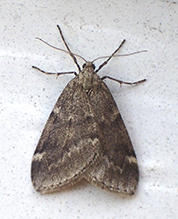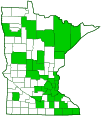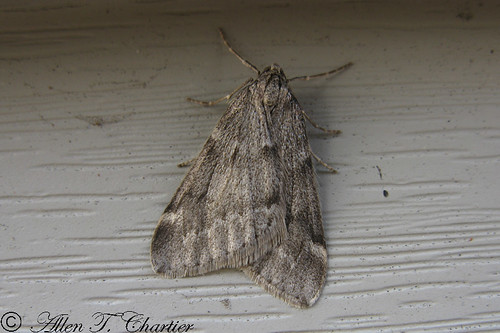fall cankerworm moth
(Alsophila pometaria)
Conservation • Description • Habitat • Ecology • Distribution • Taxonomy
|
||||||||
| Hodges # | 6258 |
|||||||
Conservation Status |
||||||||
| IUCN Red List | not listed |
|||||||
| NatureServe | NNR - Unranked SNR - Unranked |
|||||||
| Minnesota | not listed |
|||||||
Description |
||
Fall cankerworm moth is a common, native, typical geometer moth. It occurs throughout the continental United States and southern Canada. It is most common east of the Great Plains. It is common in Minnesota. It is found in a variety of wooded habitats, including natural areas, managed woodlands, orchards, parks, and urban areas. Adults are short-lived. They are active in the fall after a hard freeze, from late September to mid-November. Males feed on flower nectar. Females have non-functional mouthparts and do not feed. The larvae feed on the leaves of a variety of trees and shrubs, especially ash, basswood, cherry, elm, maple, oak, and beech, but also on apple, birch, blueberry, dogwood, hickory, rose, walnut, and willow. Fall cankerworm moth is a serious economic pest. In some areas, it has periodic eruptive outbreaks. Large numbers can completely defoliate a tree. If defoliated two years in a row, the tree may die, especially if it was weakened by drought. Adult males are about ½″ (12 mm) in length and have a 1″ to 1⅜″ (25 to 35 mm) wingspan. Females are 5⁄16″ to ½″ (8 to 12 mm) in length and do not have wings. The male forewings are glossy brownish gray with pale and dark markings. They are peppered with dark brown and light gray scales. The antemedial (AM) and postmedial (PM) lines are jagged. The AM line is pale with a dark shadow below. The PM line is pale with a dark shadow above and sometimes a dark spot on each vein. It bends at a right angle near the leading edge (costal margin), and then it broadens into a large pale patch below with a dark patch above. The terminal line is a row of small dark spots sometimes more or less connected by a thin dark line. There is occasionally a visible dark discal spot. The hindwings are light gray with a faint PM line and a dark discal spot. The female looks nothing like a moth. The body is glossy and is mottled with dark and pale brownish gray. The caterpillar is slender and up to 1″ (2.5 cm) in length. The color ranges from pale green and yellow to black. The spiracles are bordered with a thin black line within a broader white border. Darker color forms appear when population density is high. There are four developmental stages (instars), and the appearance varies greatly with each instar. Second instars have the beginnings of a darkish stripe above bordered by light, narrow lines. Third instars of the light color morph have a pair of whitish lines above near the middle (subdorsal). Third instars of the dark color morph have a broad black stripe above and a whitish line below the breathing pores (spiracles). Unlike other moths, fall cankerworm moth has a third pair of abdominal leg-like structures (prolegs). The third proleg is on the fifth abdominal segment and it is half the size of the other prolegs. |
||
Size |
||
Male total length: about ½″ (12 mm) Female total length: 5⁄16″ to ½″ (8 to 12 mm) Wingspan: 1″ to 1⅜″ (25 to 35 mm) |
||
Similar Species |
||
Habitat |
||
Wooded habitats, including natural areas, managed woodlands, orchards, parks, and urban areas |
||
Ecology |
||
Season |
||
One generation per year: Late September to mid-November |
||
Behavior |
||
|
||
Life Cycle |
||
The female lays a mass of up to 200 eggs in tightly spaced rows in a single layer on a small branch in the crown of a host tree or shrub. The eggs overwinter and hatch in the spring around the same time as the host leaf buds break. Young caterpillars disperse by “ballooning”. They spin a long thread of silk and let go of the plant they are on, letting the wind or breeze carry them to a new location. The caterpillar will repeat this process until it lands on a suitable host. Young caterpillars skeletonize the leaves, but older ones leave just the midrib. In five or six weeks, mature caterpillars spin down to the ground. They pupate in the ground in a silken cocoon. Adults emerge in the fall after a hard freeze. Adults are short lived, surviving just a few weeks. Males emerge before females and die soon after mating. Females die soon after laying eggs. Females in some populations are able to produce offspring (clones) without mating (parthenogenetically). The clones specialize on a single host species. The clone’s emergence the following spring coincides with the emergence of leaves on their host.4 |
||
Larva Food |
||
Leaves of trees and shrubs, including ash, basswood, cherry, elm, maple, oak, beech, apple, birch, blueberry, dogwood, hickory, rose, walnut, and willow. |
||
Adult Food |
||
Males feed on flower nectar. Females have nonfunctional mouthparts and do not feed. |
||
Distribution |
||||
|
Sources |
|||
| 10/31/2023 | ||||
Occurrence |
||||
Common |
||||
Taxonomy |
|||
Order |
Lepidoptera (Butterflies and Moths) | ||
Superfamily |
Geometroidea (Geometrid and Swallowtail Moths) | ||
Family |
Geometridae (Geometer Moths) | ||
Subfamily |
Ennominae (Typical Geometers) | ||
Tribe |
Alsophilini | ||
Genus |
Alsophila | ||
This species was originally described as Anisopteryx pometaria in 1841. In 1896 it was moved to the genus Alsophila. |
|||
Synonyms |
|||
Anisopteryx autumnata Anisopteryx pometaria Anisopteryx restituens |
|||
Common Names |
|||
fall cankerworm fall cankerworm moth |
|||
Glossary
Antemedial (AM) line
A thin line separating the basal area and the median area of the forewing of Lepidoptera.
Costal margin
The leading edge of the forewing of insects.
Instar
The developmental stage of arthropods between each molt; in insects, the developmental stage of the larvae or nymph.
Postmedial (PM) line
A thin line separating the median area and the postmedial area of the forewing of Lepidoptera.
Proleg
A fleshy structure on the abdomen of some insect larvae that functions as a leg, but lacks the five segments of a true insect leg.
Spiracle
A small opening on the surface of an insect or arachnid through which it breathes.
Visitor Photos |
|||||
Share your photo of this insect. |
|||||
| This button not working for you? Simply email us at info@MinnesotaSeasons.com. Attach one or more photos and, if you like, a caption. |
|||||
Babette Kis |
|||||
Alsophila pometaria (fall cankerworm moth) Alsophila pometaria (fall cankerworm moth), … Wisconsin. Photo was taken November 3, 2020 in Milwaukee, WI. |
 |
||||
MinnesotaSeasons.com Photos |
|||||
|
|||||

Visitor Videos |
|||
Share your video of this insect. |
|||
| This button not working for you? Simply email us at info@MinnesotaSeasons.com. Attach a video, a YouTube link, or a cloud storage link. |
|||
Other Videos |
|||
| Alsophila pometaria courtship Kristof Zyskowski |
|||
About
Jan 1, 2022 This video documents an encounter with Fall Cankerworm Moth (Geometridae: Alsophila pometaria) in the Sleeping Giant State Park in Hamden, Connecticut, USA. Two males were found fluttering near the base of an oak tree. They were zeroing in on a wingless female moth perched on the tree, apparently guided by her pheromones. One of the males succeeded locating her and the video shows his attempts to copulate with her. |
|||
| Fall cankerworm Alsophila pometaria attack from the trees!🐛🍃🍂 LuckyStone888 |
|||
About
Sep 2, 2023 Fall cankerworm (Alsophila pometaria) is a common native pest in Massachusetts. the fall cankerworm is a moth of the family Geometridae. The species was first described in English by the KJV Bible [Joel 1:4]. It is found in North America from Nova Scotia west to Alberta, south to Colorado and California |
|||
| Fall Cankerworm Moth (Geometridae: Alsophila pometaria) Winged Adult Male Carl Barrentine |
|||
About
Mar 18, 2012 This species is normally common in our area during the late fall (Oct-Nov) in our area, but a few individuals do overwinter and are found in the Spring when the Spring Cankerworm (Paleacrita vernata) adults are breeding. Photographed at the Turtle River State Park, North Dakota (18 March 2012). |
|||
| Fall Cankerworm Moth (Geometridae: Alsophila pometaria) Female with Eggs Carl Barrentine |
|||
About
Oct 22, 2011 Photographed at the Turtle River State Park, North Dakota (22 October 2011). |
|||

Visitor Sightings |
|||||
Report a sighting of this insect. |
|||||
| This button not working for you? Simply email us at info@MinnesotaSeasons.com. Be sure to include a location. |
|||||
| Babette Kis 11/3/2020 |
Location: Milwaukee, WI Alsophila pometaria (fall cankerworm moth), … Wisconsin. Photo was taken November 3, 2020 in Milwaukee, WI. |
 |
|||
MinnesotaSeasons.com Sightings |
|||||
|
|||||

Created: 10/31/2023
Last Updated:


